KARPATHOS
Religion

Religion
Popular destinations GREECE
| Aegina | Alonissos | Andros |
| Chios | Corfu | Crete |
| Hydra | Kalymnos | Karpathos |
| Kefalonia | Kos | Lefkas |
| Lesbos | Mykonos | Naxos |
| Paros | Patmos | Peloponnese |
| Poros | Rhodes | Samos |
| Santorini | Skiathos | Skopelos |
| Spetses | Thasos | Zakynthos |
Religion
Religious buildings on Karpathos
KARPATHOS-TOWN
The church of Agii Apóstolí, built only in 1975, is interesting because of the wall paintings by Manólis Filippákis from Olympos. The cemetery of Karpathos Town is located near the church of Agios Nikolaos.
On Afoti beach are the remains, three columns and some choir gates, of the early Christian basilica of Agia Fotini from the late 4th, early 5th century.
MENETES
St. Mary's Church with eight early Christian columns from 1845.
The chapel Agios Mamas has a dome with a depiction of the Ascension of Jesus. On the walls are heads of saints and the frescoes are from the 14th or 15th century.
ARKASSA
Remains of the church of Agia Sofia, excavated in 1923, an early Christian basilica of the 5th/6th centuries with early Byzantine floor mosaics.
Panagia Marmarini Church.
Remains of the Basilica of Eucharistos, dating from the end of the 5th century and named after a bishop.
APERI
Uninhabited monastery Moni Agiou Georgiou Vasson. Aperi houses the seat of the Archbishop of Karpathos and Kassos. In 1886, the Episcopal Church was built near the Chapel of the Assumption of Virgin Mary.
DIAFANI
Approximately 300 years old St. Mary's Church, built on the foundations of a Byzantine church. Also the Agios Nikalaos chapel.
KYRA PANAGIA
White Marian church with a dark red dome.
LEFKOS
Chapel of Panagia Gialochorafitissa.
MESOHORI
Three chapels, Agia Triada, and two 18th century churches, Agios Nikolaos (1764) and Agios Stavros (ca. 1700). There is also Agios Ioannis (1781) with 18th century wall paintings depicting the life of Christ and a beautiful iconostasis.
South of Mesohori, situated in a narrow ravine, is the 12th century church of Agios Georgios tou Lefkou, architecturally unique to Karpathos and with paintings of St. Dimitrios and an angel.
OLYMPOS
Olympos has two ruins of 12th century churches, the chapel Agios Onouphrios and the Agia Triada. There is also the 18th century Agia Vervara church. In a valley east of Olympos there are two chapels, the Agia Saranda and the Agia Anna. The Agia Anna is very special because of its wall paintings with non-figurative, mostly geometric decorations in the colours red, black and white, a rare example of aniconic art, i.e. without depictions of God or other living beings. There is also the parish church of 'Kimissi tis Panagias'.
POA
Ruins of the early Christian basilica of Panagia Eftavatousa. On the same site now stands a modern chapel with 5th/6th century fragments of coloured mosaic floor.
VOLADA
Genesis tis Theotokou church with a Marian icon dated 1791. Nearby is a chapel of Timios Stavros.
KASSOS
In the Chadies area, in the south-western part of the island of Kassos, is the touristically interesting whitewashed Agios Georgios Monastery. The foundations are 17th century, the murals of the catholicon are late 20th century.
19th century Agios Spyridonas church in the capital Fri, named after the patron saint of Kassos.
Just outside the village is the new cave church Panagia Potamitissa.
Of particular note are the six chapels that tower in battle order above the village of Emboreió. The 18th century church of the village of Panaghia is the oldest parish church on Kassos and has a remarkably beautiful bell tower.
Just outside the village of Poli is the Agios Mamas Monastery.
SARIA
Modern Agia Sophia chapel on the island of Saria, built on the foundations of a 5th century basilica. Above the bay of Palatia is a white chapel, Agias Zacharias.
Karpathos and mythology
According to mythology, the god who gave fire to mankind, Prometheus, was born on Karpathos. Prometheus was later punished by the supreme god Zeus for stealing fire from the gods and then giving it to humans. Prometheus, son of the titan Lapetus, was chained to a rock, where the eagle Ethon pecked out pieces of his liver, which then grew back.
Greek mythology
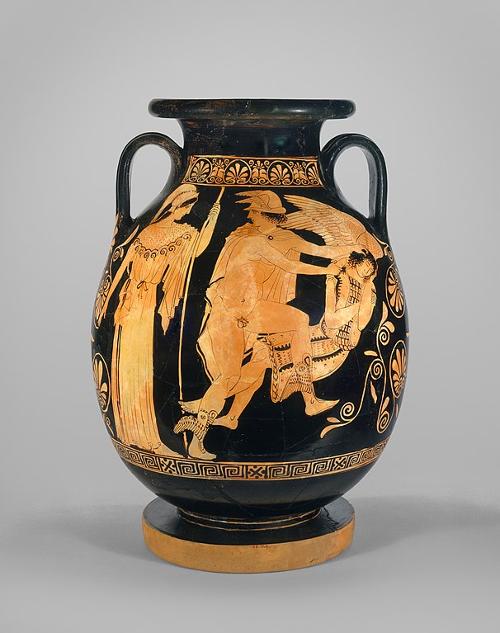 Mythological image on a vase, GreecePhoto: Public domain
Mythological image on a vase, GreecePhoto: Public domain
The word myth is derived from the word "muthos", which first meant utterance and was later often interpreted as "a spoken or written story".
Mythology (muthologia) is thus "telling stories", or a collection of myths, or the study of myths.
When writing originated in Greece, myths and legends were already anchored in oral traditions, and later poets in particular gave the stories a different course. Greek mythology is very similar to other mythologies. For example, the Norse god Odin corresponds to the Greek Zeus and the Norse heroes often performed the same heroic deeds as their Greek colleagues.
Some Greek Gods:
Aeolus (Aiolos)
A son of Hippotes, who was appointed by Zeus as guardian of the winds. He was in charge of the (wind) gods: Boreas, Zephyros, Notos and Euros.
Aphrodite
Aphrodite is the goddess of love and beauty. She was born from the foam of the sea, where the main shrine dedicated to Aphrodite is located. She was married to Hephaestus, but preferred Ares for a lover.
Her son was Eros, the god of love. Aphrodite is depicted with the winged Eros and with doves. She was one of the Olympian gods. The Romans called her Venus.
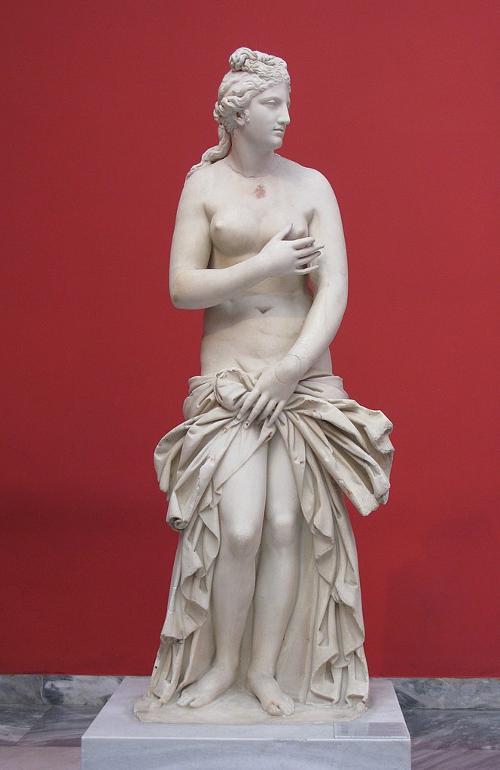 Aphrodite, goddess of love and beauty, GreecePhoto: Tilemahos Efthimiadis CC 2.0 Generic no changes made
Aphrodite, goddess of love and beauty, GreecePhoto: Tilemahos Efthimiadis CC 2.0 Generic no changes made
Apollo
Apollo was the son of Zeus and Leto, and the twin brother of Artemis. He is god of light, of medicine, music and science. Apollo is often depicted with a lyre in his hand. The main shrine dedicated to Apollo is located in Delphi, the most important oracle site of ancient Greece. Apollo was an Olympic god.
Ares
Ares was a son of Zeus and Hera and is the god of war. He is often depicted in full armor and was an Olympian god. The Romans take him Mars.
Artemis
Artemis was Apollo's twin sister and daughter of Zeus and Leto. She was the goddess of nature and the hunt. She was also the tutelary goddess of pregnant women and is often depicted with a bow in her hand. She was an Olympian god and her Roman name is Diana.
Dionysos
Dionysos was a son of Zeus and god of grapes and wine. He is often depicted with a staff that is wrapped at the top with ivy leaves. He was an Olympian god and his Roman name is Bacchus or Liber.
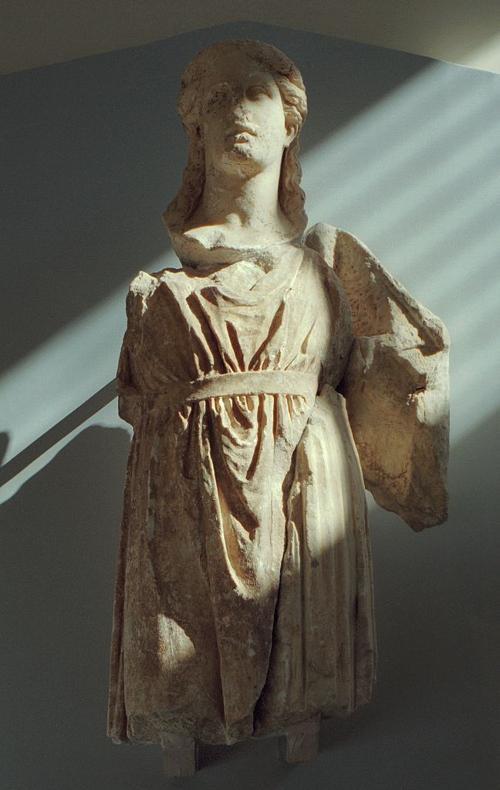 Dionysos, GreecePhoto: Zde CC 4.0 International no changes made
Dionysos, GreecePhoto: Zde CC 4.0 International no changes made
Eros
Eros is the god of needs and is also called Himeros. Eros is often seen as a winged boy god who shoots men in the heart with love arrows. Roman names for him are Amor and Cupid.
Hermes
Hermes was the messenger of the gods and a son of Zeus. He is also god of travelers, thieves, and merchants. He is always depicted wearing a traveler cap and staff or a helmet with wings. His sandals also have wings. He escorted the ghosts of the dead into the underworld, Hades.
Pallas Athena
She is the daughter of Zeus only, because born from his forehead. She is the patron goddess of the artists and craftsmen, but also the goddess of wisdom and knowledge. In wartime Athena was also worshiped as a war goddess. She was the special guardian goddess of the city of Athens and a guardian angel of Greek heroes such as Heracles and Odysseus.
She is often depicted wearing a helmet and full armor. The owl, which symbolizes wisdom, was devoted to her. Pallas Athena has a sanctuary located in Athens: the Parthenon. She was an Olympian god and her Roman name is Minerva.
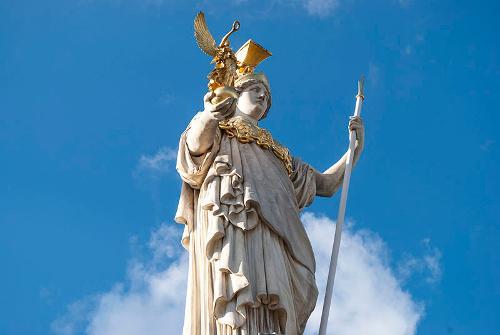 Pallas Athena GreecePhoto: Diana Ringo CC 3.0 Austria no changes made
Pallas Athena GreecePhoto: Diana Ringo CC 3.0 Austria no changes made
Poseidon
Poseidon is a helm of Zeus and is the god of the sea and guardian god of the sailors. His palace is deep under water and he is often depicted with a trident, with which he can stir the sea. The horse was dedicated to him.
Because the Greeks believed that the land floated on the sea, they also considered him the god who caused the earthquakes. The Roman name is Jupiter.
Zeus
Zeus was the supreme god of the Greeks and the king of gods and men. He was also the god of the sky and the weather. He is often depicted with a lightning in his hand and is seated on a throne. Many demigods and heroes, such as Hercules and Perseus, arose from his love affairs with beautiful women.
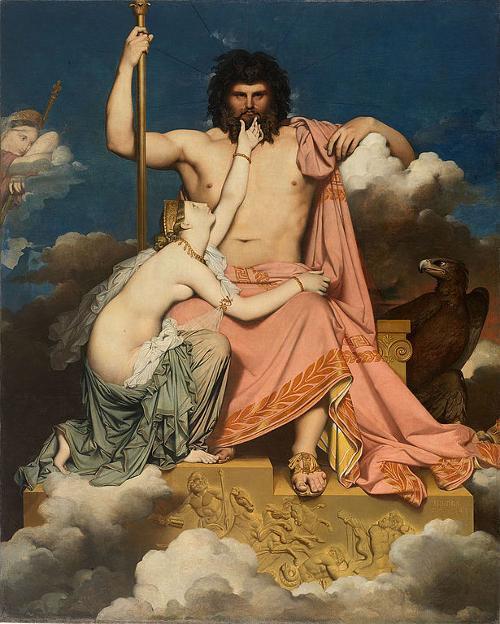 Zeus and Thetis, GreecePhoto: Public domain
Zeus and Thetis, GreecePhoto: Public domain
Sources
Wikipedia
CIA - World Factbook
BBC - Country Profiles
Copyright: Team The World of Info